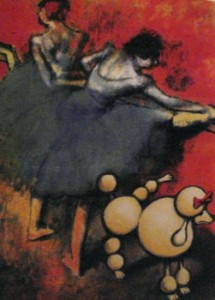Keith Costas, Director of Special Events
What is your major selling point for the Phillips to be used as a special events location?
The Phillips Collection is a unique venue in the heart of Dupont Circle. The beauty of hosting an event at the museum is its intimacy and feeling of being in someone’s private home surrounded by magnificent works of art. There is no other venue like this in Washington, D.C., where you can enjoy cocktails in the parlors and view major works by American and European artists. The spectacular Music Room is a wonderful setting for seated dinners, receptions, and musical performances. So often when I lead potential clients through the museum, they exclaim how beautiful and grand the Music Room is. From then on it is a pretty easy sell.
What’s your museum background–and is it particularly difficult to coordinate such things at an art museum?
I spent two years at the National Gallery of Art assisting with events, five years catering events in the Katzen Arts Center at American University and spent a good part of my earlier catering and special events career managing events in museums, embassies, cultural venues, and private residences. By far, The Phillips Collection is one of the more difficult venues in D.C. in which to work. Our voluntary agreement with our neighbors near the museum governs the number, size, logistics, and duration of special events held at the museum each year. The fact that we do not allow any open flame within the building poses a special challenge to caterers as they prepare and service events. The delicate nature of the Music Room floor, the proximity to major works of art, and the strict timing make it imperative that we work with vendors and caterers familiar with our space and rules. It is helpful to know your vendors and caterers, their strengths and weaknesses, and to work closely with their staff to ensure every event is flawless. My rule of thumb is to never assume anything and always keep an eye on all moving parts during an event.
It is really helpful to have a dedicated and cooperative group of Museum Assistants, who are your eyes and ears during an event, as well as a sympathetic curatorial team to consult with when necessary about moving or replacing works of art for an event. Working together, we assure the safety of the collection and still allow our clients to have a wonderful event.
How did you learn about the Phillips?
I have lived in D.C. for 35 years, so the Phillips was always “that small gem” of a museum. A wonderful place to bring visiting friends and family. It wasn’t until I began to work here that I learned about the breadth of the collection, the commitment of the staff and board to make this a world-class museum, and the vital role the museum plays in the cultural environment of D.C.
Who’s your favorite artist in the collection?
I have many favorite artists, but my favorite painting is William Merritt Chase’s Hide and Seek (1888). Its theme, lighting, and cropping resonate so much with me it is hard to define. It truly is a very modern work of art. I used to vacation in Shinnecock Hills, N.Y., at my uncle’s art studio and cottage situated just below the Chase homestead where this was painted. I have fond memories of picking wild blueberries below the stately Victorian house on the hill and thinking how a talented and wonderful artist drew inspiration from the rolling hills, the light, and stunning sea views of the Hamptons.
Do you collect artwork—or anything?
After one of our first trips to Turkey and the Middle East, my wife and I began to collect tribal flat weave textiles (kilims). Most carpet weaving is created by women in some of the most remote and desolate parts of the world. The energy, imagination, choice of colors, weave, and design never ceases to amaze me. Each piece is a unique work of art that tells a story. We have since continued to collect turn-of-the-century Caucasian carpets that look like they were created yesterday with rich vibrant natural colors and soft silky piles. Needless to say, when we entertain and serve red wine they come up off of the floor! We also have a small collection of antique tiles from Turkey, Uzbekistan, Spain, and Portugal.
Which smart phone do you use?
iPhone 4s.




